|
|
|
Sort Order |
|
|
|
Items / Page
|
|
|
|
|
|
|
| Srl | Item |
| 1 |
ID:
176742
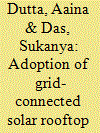

|
|
|
|
|
| Summary/Abstract |
Renewable energy is being seen as a transformative solution to meet energy as well as economic challenges at national as well as at a global level. The Government of India has expressed its intent to achieve 100 GW of solar capacity in the country by 2020. However, one such state that lags in harnessing and achieving the solar targets is the state of Jammu and Kashmir despite having the second highest potential of solar energy. Jammu and Kashmir is a power deficit state though it has one of the best potentials in solar energy. Solar rooftop PV systems can solve most of the problems regarding power deficit, but yet people are naïve about solar rooftop PV systems. The purpose of this study is to perform stakeholder analysis to investigate the perceptions of the groups/individuals regarding grid connected solar rooftop PV systems. They have a critical impact on the result of the study as they provide fundamental data on the political, social and economic scenario of any study area. The findings from the investigation underscores that all the projects and programs related to the adoption of a solar rooftop system should concentrate on building awareness.
|
|
|
|
|
|
|
|
|
|
|
|
|
|
|
|
| 2 |
ID:
124240


|
|
|
|
|
| Publication |
2013.
|
| Summary/Abstract |
Distributed energy (DE) is receiving lots of attention from the Chinese government. A number of DE projects have been constructed in China. However, there are still numerous problems with DE projects. What hinders the development of DE in China? The Huadian Jimei distributed energy project (HJDE) is a typical DE building project that was not completed successfully. This paper focuses on this DE project to explore the barriers to DE development. The research group conducted 13 semi-structured interviews with representatives of institutions and corporations involved in the HJDE project to collect information. Based on the information, three types of problems were determined, and the results indicate that these conflicts between the core stakeholders make DE projects unsuccessful. These problems result from institutional barriers to DE, rooting in the development policy and the current energy market. Moreover, several key stakeholders are not able to play an active role in the design or management of DE projects. The Chinese government will put a much greater effort into the development of future DE projects. Many national support policies and rules will be announced, which are easy to practical use. Under these conditions, 1000 DE projects will be successfully completed until 2015.
|
|
|
|
|
|
|
|
|
|
|
|
|
|
|
|
| 3 |
ID:
163547
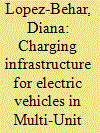

|
|
|
|
|
| Summary/Abstract |
Achieving meaningful reductions in greenhouse gas emissions from the global transportation sector will rely on a large-scale transition to electric vehicles (EVs). Many governments aim to encourage the uptake of EVs in cities, because urban areas are well suited to EV driving ranges and stand to benefit hugely from reduced local emissions. In the Canadian province of British Columbia (BC), where clean renewable electricity sourcing makes EV deployment an attractive proposition, over a quarter of residents live in Multi-Unit Residential Buildings (MURBs), most of which are not equipped with EV charging infrastructure. In a related study, Lopez-Behar et al. (accepted) explored the challenges and decision-making processes involved in the installation of EV charging infrastructure in MURBs in BC, from the perspective of different stakeholders. Here, we build on those findings to map out and analyze feedback loops within this system using a Causal Loop Diagram (CLD). We then present potential demand-focused policy interventions to address the issues raised by our modelling results, grouped into three categories: financial/fiscal, regulatory and information/awareness measures. Financial/fiscal policy measures include creating incentives for EV owners and extending them to the building owners, and programs to incentivize and provide financial aid for building owners to develop building retrofit plans. Regulatory policy measures include addressing the rights and obligations of the stakeholders and making mandatory the installation of charging stations in new MURBs. Information/awareness policy measures include expanding the existing guidelines and informing the development of a long-term EV charging infrastructure plan. Our policy recommendations are designed to inform the interventions of municipal and provincial governments in BC, but could also be relevant to many urban EV markets worldwide.
|
|
|
|
|
|
|
|
|
|
|
|
|
|
|
|
| 4 |
ID:
180846
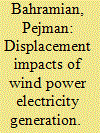

|
|
|
|
|
| Summary/Abstract |
The displacement impacts of wind power generation on other generation technologies are estimated for Ontario. In addition, their annual financial benefits, costs, and international stakeholder impacts are measured. For every 100 MWh generated, almost 53 MWh of gas output is displaced, and 19 MWh of power is exported. Due to inadequate storage capacity hydro power generation is reduced by 23 MWh. Ontario on average loses about 859 million USD annually from having wind power generation in the system, while the US gains approximately 10 million USD through electricity exported from Ontario. Wind power generation has produced an estimated 109 million USD of benefits by reducing CO2 emissions in the US and Ontario through displacing thermal generation. Comparing the environmental benefits with the net cost to consumers shows the promotion of wind power generation to be largely a waste of Ontario's resources.
|
|
|
|
|
|
|
|
|
|
|
|
|
|
|
|
| 5 |
ID:
117260
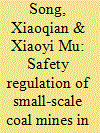

|
|
|
|
|
| Publication |
2013.
|
| Summary/Abstract |
Small scale coal mines (SCMs) have played an important role in China's energy supply. At the same time, they also suffer from many social, economic, environmental, and safety problems. The Chinese government has made considerable efforts to strengthen the safety regulation of the coal mining industry. Yet, few of these efforts have proven to be very effective. This paper analyzes the interests and influences of key stakeholders in the safety regulation of SCMs, which includes the safety regulator, the local government, the mine owner, and mineworkers. We argue that the effective regulation of coal mine safety must both engage and empower mineworkers.
|
|
|
|
|
|
|
|
|
|
|
|
|
|
|
|
| 6 |
ID:
171433
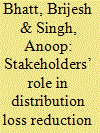

|
|
|
|
|
| Summary/Abstract |
Reduction of distribution losses is the key to sustainability of entire Indian power sector. Although sufficient emphasis has been placed on adoption of distribution loss reduction technologies (LRT) such as high voltage distribution system, it has not made significant inroads. Building on new institutional economics and sociological approaches, we propose actor analysis as a prerequisite for understanding barriers to technology adoption. The approach emphasizes understanding of action situations and power, interests and interdependencies of involved actors for LRT adoption. Using the method of stakeholder analysis, the study identifies key actors and their interdependencies in LRT adoption processes. The paper concludes that loss reduction and LRT adoption policies can be effectively implemented by engaging consumers through information sharing and, by showcasing advantages of LRT projects especially those leading to improvement in quality of electricity supply.
|
|
|
|
|
|
|
|
|
|
|
|
|
|
|
|
|
|
|
|
|